Unit 26: Facilitating Change in Health and Social Care - Care Act 2014
VerifiedAdded on 2023/01/13
|12
|3933
|93
Report
AI Summary
This report provides a comprehensive analysis of the Care Act 2014 and its implications for the health and social care sector in the UK. The report begins by identifying the key factors driving change, such as economic, demographic, societal, and sectoral influences, that necessitated the implementation of the Care Act. It then delves into the challenges associated with these drivers, including resistance to change, the importance of continuous professional development and ICT integration, maintaining quality care, balancing efficiency with economy, and managing human and financial resources. The report further explores strategies and criteria for measuring recent changes, including regulatory inspections, organizational quality assurance systems, and feedback mechanisms. It assesses the impact of the Care Act against these criteria, highlighting benefits to users, improvements in delivery and referral rates, and cost-effectiveness. Finally, the report proposes responses to the changes, such as updating procedures and policies to promote adaptability, and concludes with an overview of the key principles of change management, planning, and monitoring within the context of the Care Act's implementation.
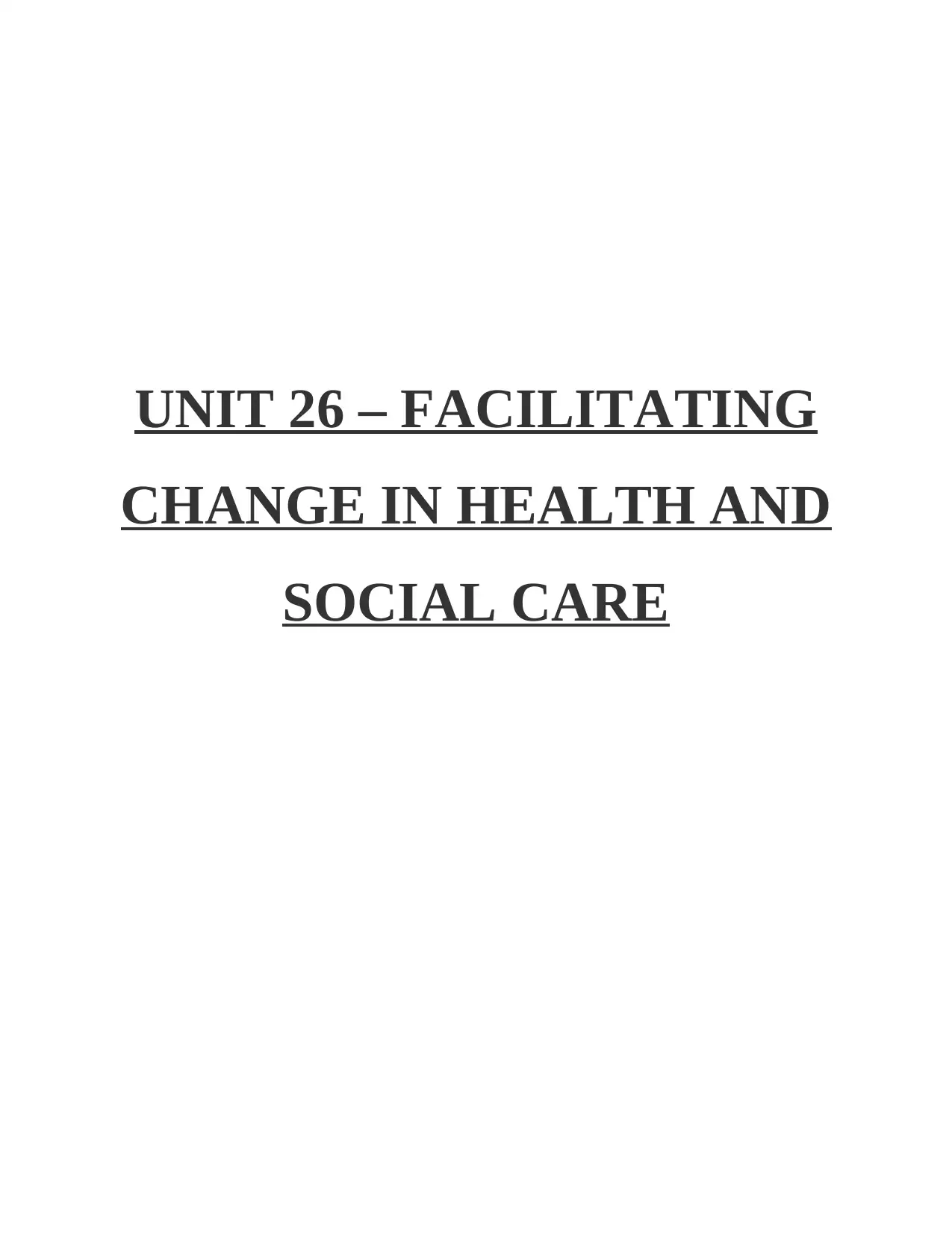
UNIT 26 – FACILITATING
CHANGE IN HEALTH AND
SOCIAL CARE
CHANGE IN HEALTH AND
SOCIAL CARE
Paraphrase This Document
Need a fresh take? Get an instant paraphrase of this document with our AI Paraphraser
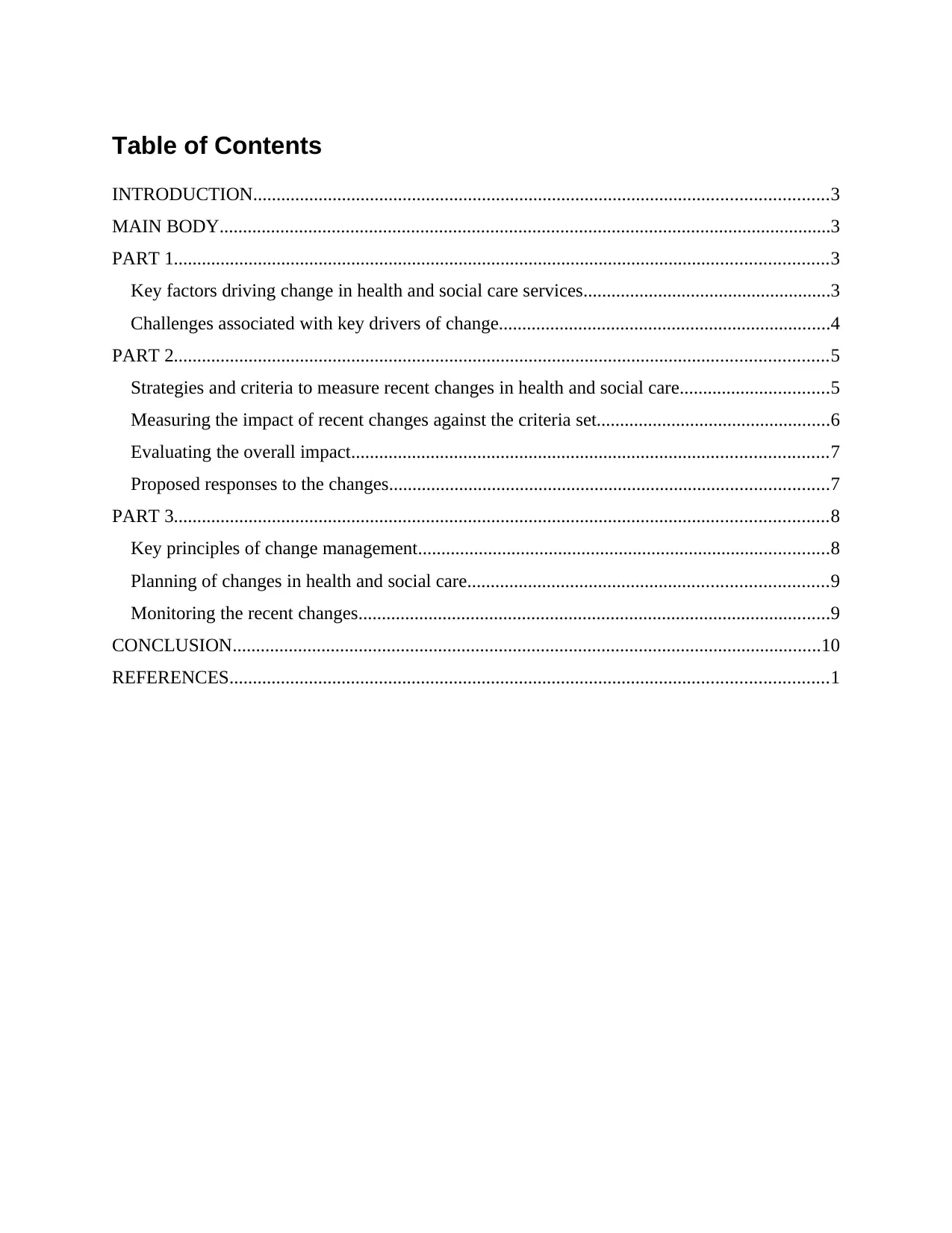
Table of Contents
INTRODUCTION...........................................................................................................................3
MAIN BODY...................................................................................................................................3
PART 1............................................................................................................................................3
Key factors driving change in health and social care services.....................................................3
Challenges associated with key drivers of change.......................................................................4
PART 2............................................................................................................................................5
Strategies and criteria to measure recent changes in health and social care................................5
Measuring the impact of recent changes against the criteria set..................................................6
Evaluating the overall impact......................................................................................................7
Proposed responses to the changes..............................................................................................7
PART 3............................................................................................................................................8
Key principles of change management........................................................................................8
Planning of changes in health and social care.............................................................................9
Monitoring the recent changes.....................................................................................................9
CONCLUSION..............................................................................................................................10
REFERENCES................................................................................................................................1
INTRODUCTION...........................................................................................................................3
MAIN BODY...................................................................................................................................3
PART 1............................................................................................................................................3
Key factors driving change in health and social care services.....................................................3
Challenges associated with key drivers of change.......................................................................4
PART 2............................................................................................................................................5
Strategies and criteria to measure recent changes in health and social care................................5
Measuring the impact of recent changes against the criteria set..................................................6
Evaluating the overall impact......................................................................................................7
Proposed responses to the changes..............................................................................................7
PART 3............................................................................................................................................8
Key principles of change management........................................................................................8
Planning of changes in health and social care.............................................................................9
Monitoring the recent changes.....................................................................................................9
CONCLUSION..............................................................................................................................10
REFERENCES................................................................................................................................1
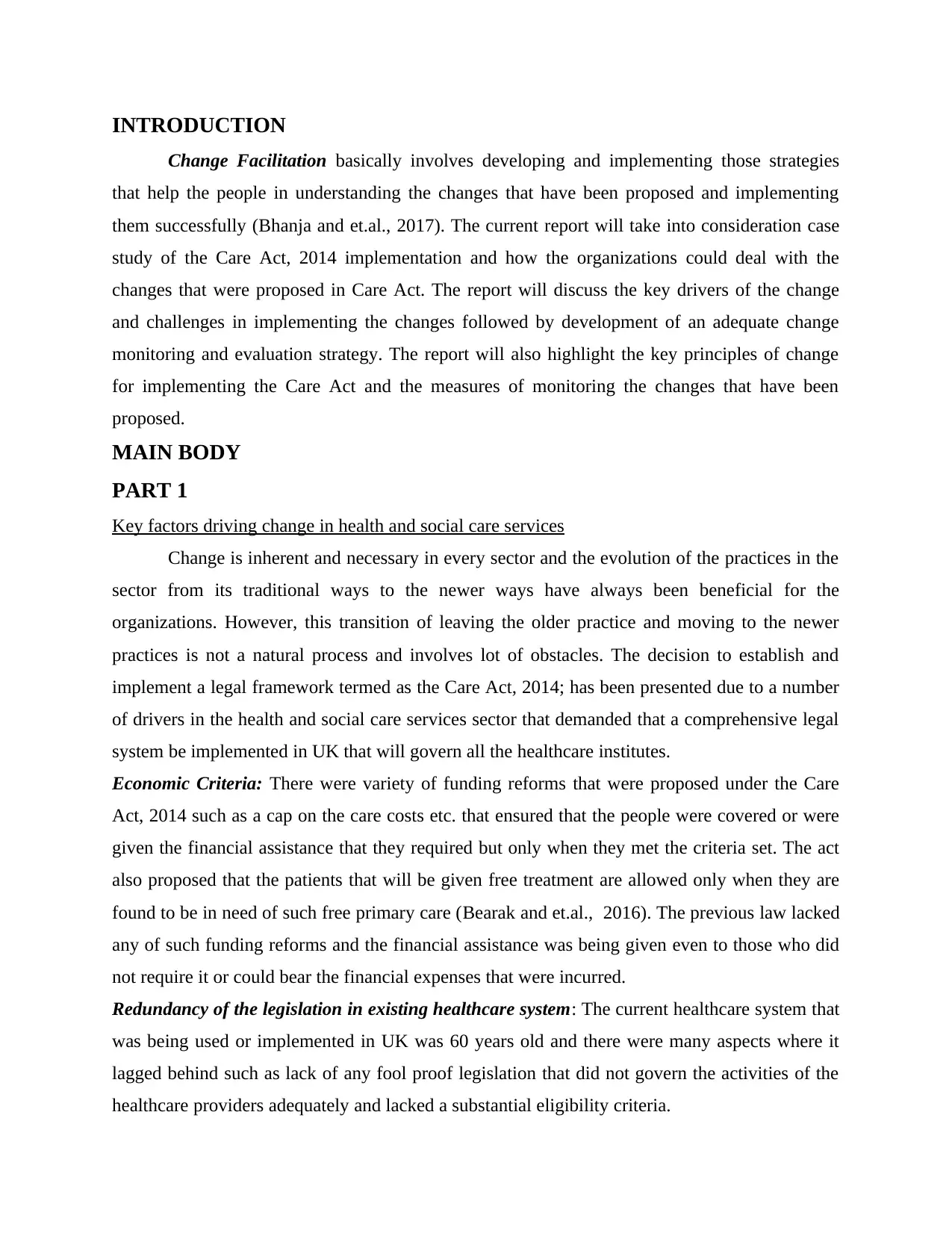
INTRODUCTION
Change Facilitation basically involves developing and implementing those strategies
that help the people in understanding the changes that have been proposed and implementing
them successfully (Bhanja and et.al., 2017). The current report will take into consideration case
study of the Care Act, 2014 implementation and how the organizations could deal with the
changes that were proposed in Care Act. The report will discuss the key drivers of the change
and challenges in implementing the changes followed by development of an adequate change
monitoring and evaluation strategy. The report will also highlight the key principles of change
for implementing the Care Act and the measures of monitoring the changes that have been
proposed.
MAIN BODY
PART 1
Key factors driving change in health and social care services
Change is inherent and necessary in every sector and the evolution of the practices in the
sector from its traditional ways to the newer ways have always been beneficial for the
organizations. However, this transition of leaving the older practice and moving to the newer
practices is not a natural process and involves lot of obstacles. The decision to establish and
implement a legal framework termed as the Care Act, 2014; has been presented due to a number
of drivers in the health and social care services sector that demanded that a comprehensive legal
system be implemented in UK that will govern all the healthcare institutes.
Economic Criteria: There were variety of funding reforms that were proposed under the Care
Act, 2014 such as a cap on the care costs etc. that ensured that the people were covered or were
given the financial assistance that they required but only when they met the criteria set. The act
also proposed that the patients that will be given free treatment are allowed only when they are
found to be in need of such free primary care (Bearak and et.al., 2016). The previous law lacked
any of such funding reforms and the financial assistance was being given even to those who did
not require it or could bear the financial expenses that were incurred.
Redundancy of the legislation in existing healthcare system: The current healthcare system that
was being used or implemented in UK was 60 years old and there were many aspects where it
lagged behind such as lack of any fool proof legislation that did not govern the activities of the
healthcare providers adequately and lacked a substantial eligibility criteria.
Change Facilitation basically involves developing and implementing those strategies
that help the people in understanding the changes that have been proposed and implementing
them successfully (Bhanja and et.al., 2017). The current report will take into consideration case
study of the Care Act, 2014 implementation and how the organizations could deal with the
changes that were proposed in Care Act. The report will discuss the key drivers of the change
and challenges in implementing the changes followed by development of an adequate change
monitoring and evaluation strategy. The report will also highlight the key principles of change
for implementing the Care Act and the measures of monitoring the changes that have been
proposed.
MAIN BODY
PART 1
Key factors driving change in health and social care services
Change is inherent and necessary in every sector and the evolution of the practices in the
sector from its traditional ways to the newer ways have always been beneficial for the
organizations. However, this transition of leaving the older practice and moving to the newer
practices is not a natural process and involves lot of obstacles. The decision to establish and
implement a legal framework termed as the Care Act, 2014; has been presented due to a number
of drivers in the health and social care services sector that demanded that a comprehensive legal
system be implemented in UK that will govern all the healthcare institutes.
Economic Criteria: There were variety of funding reforms that were proposed under the Care
Act, 2014 such as a cap on the care costs etc. that ensured that the people were covered or were
given the financial assistance that they required but only when they met the criteria set. The act
also proposed that the patients that will be given free treatment are allowed only when they are
found to be in need of such free primary care (Bearak and et.al., 2016). The previous law lacked
any of such funding reforms and the financial assistance was being given even to those who did
not require it or could bear the financial expenses that were incurred.
Redundancy of the legislation in existing healthcare system: The current healthcare system that
was being used or implemented in UK was 60 years old and there were many aspects where it
lagged behind such as lack of any fool proof legislation that did not govern the activities of the
healthcare providers adequately and lacked a substantial eligibility criteria.
⊘ This is a preview!⊘
Do you want full access?
Subscribe today to unlock all pages.

Trusted by 1+ million students worldwide
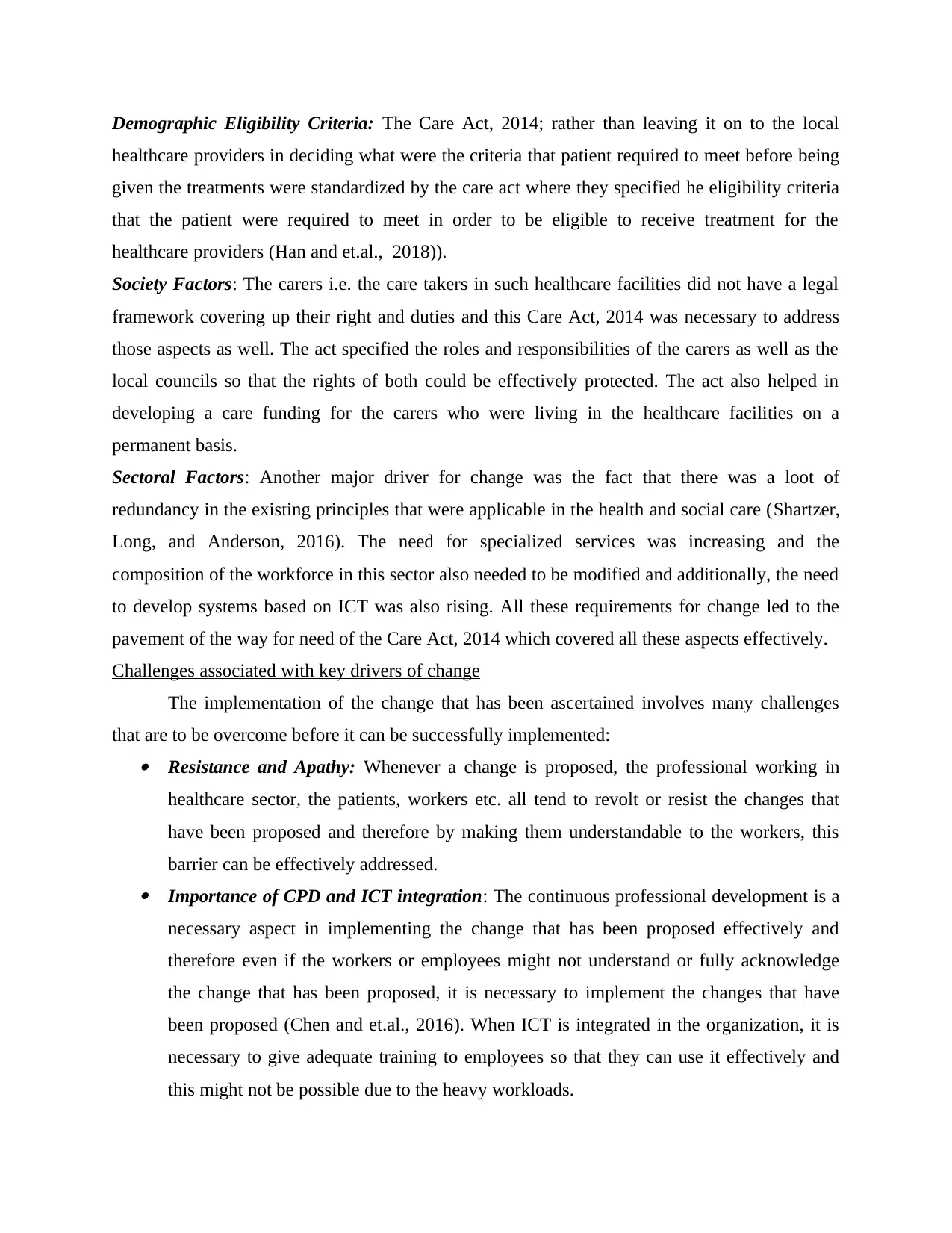
Demographic Eligibility Criteria: The Care Act, 2014; rather than leaving it on to the local
healthcare providers in deciding what were the criteria that patient required to meet before being
given the treatments were standardized by the care act where they specified he eligibility criteria
that the patient were required to meet in order to be eligible to receive treatment for the
healthcare providers (Han and et.al., 2018)).
Society Factors: The carers i.e. the care takers in such healthcare facilities did not have a legal
framework covering up their right and duties and this Care Act, 2014 was necessary to address
those aspects as well. The act specified the roles and responsibilities of the carers as well as the
local councils so that the rights of both could be effectively protected. The act also helped in
developing a care funding for the carers who were living in the healthcare facilities on a
permanent basis.
Sectoral Factors: Another major driver for change was the fact that there was a loot of
redundancy in the existing principles that were applicable in the health and social care (Shartzer,
Long, and Anderson, 2016). The need for specialized services was increasing and the
composition of the workforce in this sector also needed to be modified and additionally, the need
to develop systems based on ICT was also rising. All these requirements for change led to the
pavement of the way for need of the Care Act, 2014 which covered all these aspects effectively.
Challenges associated with key drivers of change
The implementation of the change that has been ascertained involves many challenges
that are to be overcome before it can be successfully implemented: Resistance and Apathy: Whenever a change is proposed, the professional working in
healthcare sector, the patients, workers etc. all tend to revolt or resist the changes that
have been proposed and therefore by making them understandable to the workers, this
barrier can be effectively addressed. Importance of CPD and ICT integration: The continuous professional development is a
necessary aspect in implementing the change that has been proposed effectively and
therefore even if the workers or employees might not understand or fully acknowledge
the change that has been proposed, it is necessary to implement the changes that have
been proposed (Chen and et.al., 2016). When ICT is integrated in the organization, it is
necessary to give adequate training to employees so that they can use it effectively and
this might not be possible due to the heavy workloads.
healthcare providers in deciding what were the criteria that patient required to meet before being
given the treatments were standardized by the care act where they specified he eligibility criteria
that the patient were required to meet in order to be eligible to receive treatment for the
healthcare providers (Han and et.al., 2018)).
Society Factors: The carers i.e. the care takers in such healthcare facilities did not have a legal
framework covering up their right and duties and this Care Act, 2014 was necessary to address
those aspects as well. The act specified the roles and responsibilities of the carers as well as the
local councils so that the rights of both could be effectively protected. The act also helped in
developing a care funding for the carers who were living in the healthcare facilities on a
permanent basis.
Sectoral Factors: Another major driver for change was the fact that there was a loot of
redundancy in the existing principles that were applicable in the health and social care (Shartzer,
Long, and Anderson, 2016). The need for specialized services was increasing and the
composition of the workforce in this sector also needed to be modified and additionally, the need
to develop systems based on ICT was also rising. All these requirements for change led to the
pavement of the way for need of the Care Act, 2014 which covered all these aspects effectively.
Challenges associated with key drivers of change
The implementation of the change that has been ascertained involves many challenges
that are to be overcome before it can be successfully implemented: Resistance and Apathy: Whenever a change is proposed, the professional working in
healthcare sector, the patients, workers etc. all tend to revolt or resist the changes that
have been proposed and therefore by making them understandable to the workers, this
barrier can be effectively addressed. Importance of CPD and ICT integration: The continuous professional development is a
necessary aspect in implementing the change that has been proposed effectively and
therefore even if the workers or employees might not understand or fully acknowledge
the change that has been proposed, it is necessary to implement the changes that have
been proposed (Chen and et.al., 2016). When ICT is integrated in the organization, it is
necessary to give adequate training to employees so that they can use it effectively and
this might not be possible due to the heavy workloads.
Paraphrase This Document
Need a fresh take? Get an instant paraphrase of this document with our AI Paraphraser

Maintaining quality care: The change that has ben proposed through the Care Act, 2014,
will definitely improve the current status of the quality of care that is given in healthcare
settings. Therefore, ensuring that the policy is correctly implemented in a manner that ill
add on to the current quality level in the healthcare sector is a very crucial aspect. Matching efficiency and economy: The change that have been proposed through the
Care Act, 2014 is most likely to bring a gap between the cost incurred in implementing
the proposed changes and the efficiency in the services that will be added in the
healthcare services (Ginossar and et.al., 2019). For instance, the carers are given multiple
rights and assistance under the care act and this can be beneficial for a certain time but
the increased financial strain on the management might lead to difficulties in accepting
the change that has been proposed.
Human and Financial Resources: The human and financial resources are already well
funded and managed in the healthcare service institutes in UK but this can pose
additional challenges because the care act might give higher priority to the one sector of
employees and thus this might not be able to be implemented in the manner it was
intended (Imran and et.al., 2016).
Therefore, there are many challenges in implementing the challenges that have been
proposed under the implementation of the Care Act, 2014 in the health and social care services in
UK.
PART 2
There have been many recent changes in the healthcare sector of UK such as the Health
and Social Care Act implementation in 2012, increased role of the NICE and its guidelines,
increased integration with IT programmes, enhanced security and inspection measures etc. and
all these have affected the existing manner in which the healthcare sector used to operate in UK.
Strategies and criteria to measure recent changes in health and social care
There are various strategies that can be recommended in order to monitor and evaluate
the recent changes that have been proposed:
Regulatory Inspections: The healthcare institutes should try to conduct regular inspections after
the change has been implemented i.e. in the current case, after the implementation of the Care
Act, 2014, the organizations need to evaluate the efficiency with which the changes under this
Act have been implemented and whether the purpose with which these changes were proposed
will definitely improve the current status of the quality of care that is given in healthcare
settings. Therefore, ensuring that the policy is correctly implemented in a manner that ill
add on to the current quality level in the healthcare sector is a very crucial aspect. Matching efficiency and economy: The change that have been proposed through the
Care Act, 2014 is most likely to bring a gap between the cost incurred in implementing
the proposed changes and the efficiency in the services that will be added in the
healthcare services (Ginossar and et.al., 2019). For instance, the carers are given multiple
rights and assistance under the care act and this can be beneficial for a certain time but
the increased financial strain on the management might lead to difficulties in accepting
the change that has been proposed.
Human and Financial Resources: The human and financial resources are already well
funded and managed in the healthcare service institutes in UK but this can pose
additional challenges because the care act might give higher priority to the one sector of
employees and thus this might not be able to be implemented in the manner it was
intended (Imran and et.al., 2016).
Therefore, there are many challenges in implementing the challenges that have been
proposed under the implementation of the Care Act, 2014 in the health and social care services in
UK.
PART 2
There have been many recent changes in the healthcare sector of UK such as the Health
and Social Care Act implementation in 2012, increased role of the NICE and its guidelines,
increased integration with IT programmes, enhanced security and inspection measures etc. and
all these have affected the existing manner in which the healthcare sector used to operate in UK.
Strategies and criteria to measure recent changes in health and social care
There are various strategies that can be recommended in order to monitor and evaluate
the recent changes that have been proposed:
Regulatory Inspections: The healthcare institutes should try to conduct regular inspections after
the change has been implemented i.e. in the current case, after the implementation of the Care
Act, 2014, the organizations need to evaluate the efficiency with which the changes under this
Act have been implemented and whether the purpose with which these changes were proposed
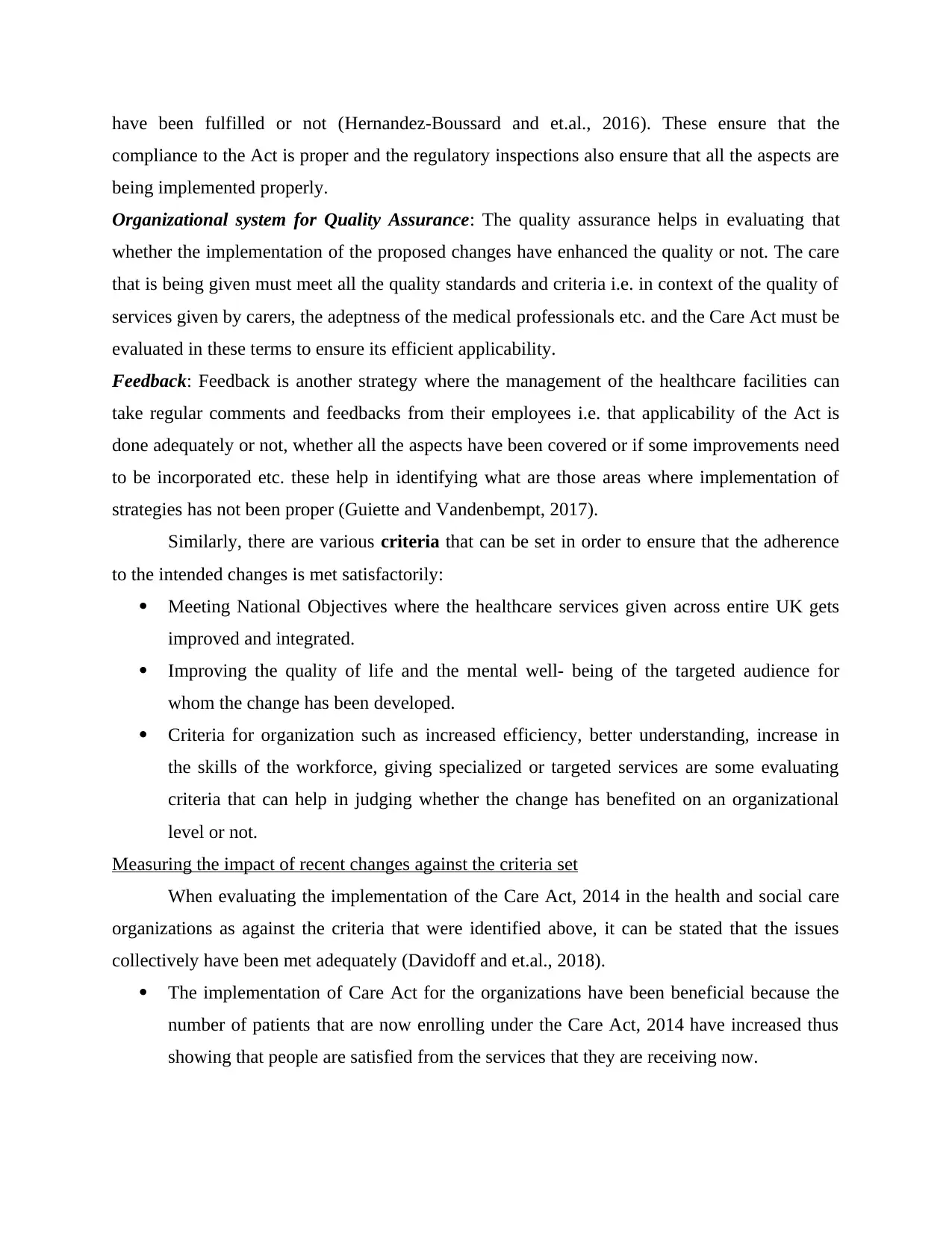
have been fulfilled or not (Hernandez-Boussard and et.al., 2016). These ensure that the
compliance to the Act is proper and the regulatory inspections also ensure that all the aspects are
being implemented properly.
Organizational system for Quality Assurance: The quality assurance helps in evaluating that
whether the implementation of the proposed changes have enhanced the quality or not. The care
that is being given must meet all the quality standards and criteria i.e. in context of the quality of
services given by carers, the adeptness of the medical professionals etc. and the Care Act must be
evaluated in these terms to ensure its efficient applicability.
Feedback: Feedback is another strategy where the management of the healthcare facilities can
take regular comments and feedbacks from their employees i.e. that applicability of the Act is
done adequately or not, whether all the aspects have been covered or if some improvements need
to be incorporated etc. these help in identifying what are those areas where implementation of
strategies has not been proper (Guiette and Vandenbempt, 2017).
Similarly, there are various criteria that can be set in order to ensure that the adherence
to the intended changes is met satisfactorily:
Meeting National Objectives where the healthcare services given across entire UK gets
improved and integrated.
Improving the quality of life and the mental well- being of the targeted audience for
whom the change has been developed.
Criteria for organization such as increased efficiency, better understanding, increase in
the skills of the workforce, giving specialized or targeted services are some evaluating
criteria that can help in judging whether the change has benefited on an organizational
level or not.
Measuring the impact of recent changes against the criteria set
When evaluating the implementation of the Care Act, 2014 in the health and social care
organizations as against the criteria that were identified above, it can be stated that the issues
collectively have been met adequately (Davidoff and et.al., 2018).
The implementation of Care Act for the organizations have been beneficial because the
number of patients that are now enrolling under the Care Act, 2014 have increased thus
showing that people are satisfied from the services that they are receiving now.
compliance to the Act is proper and the regulatory inspections also ensure that all the aspects are
being implemented properly.
Organizational system for Quality Assurance: The quality assurance helps in evaluating that
whether the implementation of the proposed changes have enhanced the quality or not. The care
that is being given must meet all the quality standards and criteria i.e. in context of the quality of
services given by carers, the adeptness of the medical professionals etc. and the Care Act must be
evaluated in these terms to ensure its efficient applicability.
Feedback: Feedback is another strategy where the management of the healthcare facilities can
take regular comments and feedbacks from their employees i.e. that applicability of the Act is
done adequately or not, whether all the aspects have been covered or if some improvements need
to be incorporated etc. these help in identifying what are those areas where implementation of
strategies has not been proper (Guiette and Vandenbempt, 2017).
Similarly, there are various criteria that can be set in order to ensure that the adherence
to the intended changes is met satisfactorily:
Meeting National Objectives where the healthcare services given across entire UK gets
improved and integrated.
Improving the quality of life and the mental well- being of the targeted audience for
whom the change has been developed.
Criteria for organization such as increased efficiency, better understanding, increase in
the skills of the workforce, giving specialized or targeted services are some evaluating
criteria that can help in judging whether the change has benefited on an organizational
level or not.
Measuring the impact of recent changes against the criteria set
When evaluating the implementation of the Care Act, 2014 in the health and social care
organizations as against the criteria that were identified above, it can be stated that the issues
collectively have been met adequately (Davidoff and et.al., 2018).
The implementation of Care Act for the organizations have been beneficial because the
number of patients that are now enrolling under the Care Act, 2014 have increased thus
showing that people are satisfied from the services that they are receiving now.
⊘ This is a preview!⊘
Do you want full access?
Subscribe today to unlock all pages.

Trusted by 1+ million students worldwide
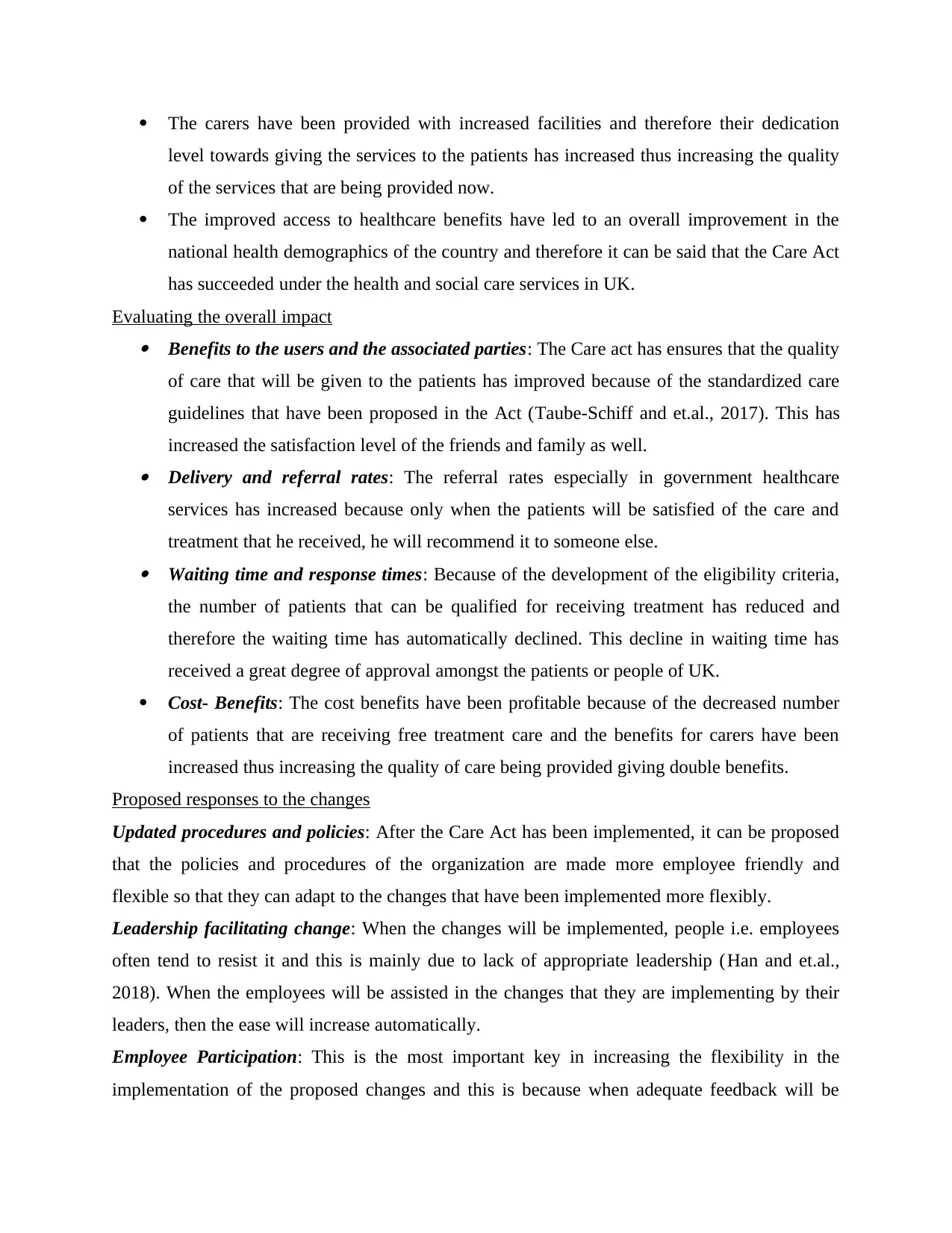
The carers have been provided with increased facilities and therefore their dedication
level towards giving the services to the patients has increased thus increasing the quality
of the services that are being provided now.
The improved access to healthcare benefits have led to an overall improvement in the
national health demographics of the country and therefore it can be said that the Care Act
has succeeded under the health and social care services in UK.
Evaluating the overall impact Benefits to the users and the associated parties: The Care act has ensures that the quality
of care that will be given to the patients has improved because of the standardized care
guidelines that have been proposed in the Act (Taube-Schiff and et.al., 2017). This has
increased the satisfaction level of the friends and family as well. Delivery and referral rates: The referral rates especially in government healthcare
services has increased because only when the patients will be satisfied of the care and
treatment that he received, he will recommend it to someone else. Waiting time and response times: Because of the development of the eligibility criteria,
the number of patients that can be qualified for receiving treatment has reduced and
therefore the waiting time has automatically declined. This decline in waiting time has
received a great degree of approval amongst the patients or people of UK.
Cost- Benefits: The cost benefits have been profitable because of the decreased number
of patients that are receiving free treatment care and the benefits for carers have been
increased thus increasing the quality of care being provided giving double benefits.
Proposed responses to the changes
Updated procedures and policies: After the Care Act has been implemented, it can be proposed
that the policies and procedures of the organization are made more employee friendly and
flexible so that they can adapt to the changes that have been implemented more flexibly.
Leadership facilitating change: When the changes will be implemented, people i.e. employees
often tend to resist it and this is mainly due to lack of appropriate leadership (Han and et.al.,
2018). When the employees will be assisted in the changes that they are implementing by their
leaders, then the ease will increase automatically.
Employee Participation: This is the most important key in increasing the flexibility in the
implementation of the proposed changes and this is because when adequate feedback will be
level towards giving the services to the patients has increased thus increasing the quality
of the services that are being provided now.
The improved access to healthcare benefits have led to an overall improvement in the
national health demographics of the country and therefore it can be said that the Care Act
has succeeded under the health and social care services in UK.
Evaluating the overall impact Benefits to the users and the associated parties: The Care act has ensures that the quality
of care that will be given to the patients has improved because of the standardized care
guidelines that have been proposed in the Act (Taube-Schiff and et.al., 2017). This has
increased the satisfaction level of the friends and family as well. Delivery and referral rates: The referral rates especially in government healthcare
services has increased because only when the patients will be satisfied of the care and
treatment that he received, he will recommend it to someone else. Waiting time and response times: Because of the development of the eligibility criteria,
the number of patients that can be qualified for receiving treatment has reduced and
therefore the waiting time has automatically declined. This decline in waiting time has
received a great degree of approval amongst the patients or people of UK.
Cost- Benefits: The cost benefits have been profitable because of the decreased number
of patients that are receiving free treatment care and the benefits for carers have been
increased thus increasing the quality of care being provided giving double benefits.
Proposed responses to the changes
Updated procedures and policies: After the Care Act has been implemented, it can be proposed
that the policies and procedures of the organization are made more employee friendly and
flexible so that they can adapt to the changes that have been implemented more flexibly.
Leadership facilitating change: When the changes will be implemented, people i.e. employees
often tend to resist it and this is mainly due to lack of appropriate leadership (Han and et.al.,
2018). When the employees will be assisted in the changes that they are implementing by their
leaders, then the ease will increase automatically.
Employee Participation: This is the most important key in increasing the flexibility in the
implementation of the proposed changes and this is because when adequate feedback will be
Paraphrase This Document
Need a fresh take? Get an instant paraphrase of this document with our AI Paraphraser
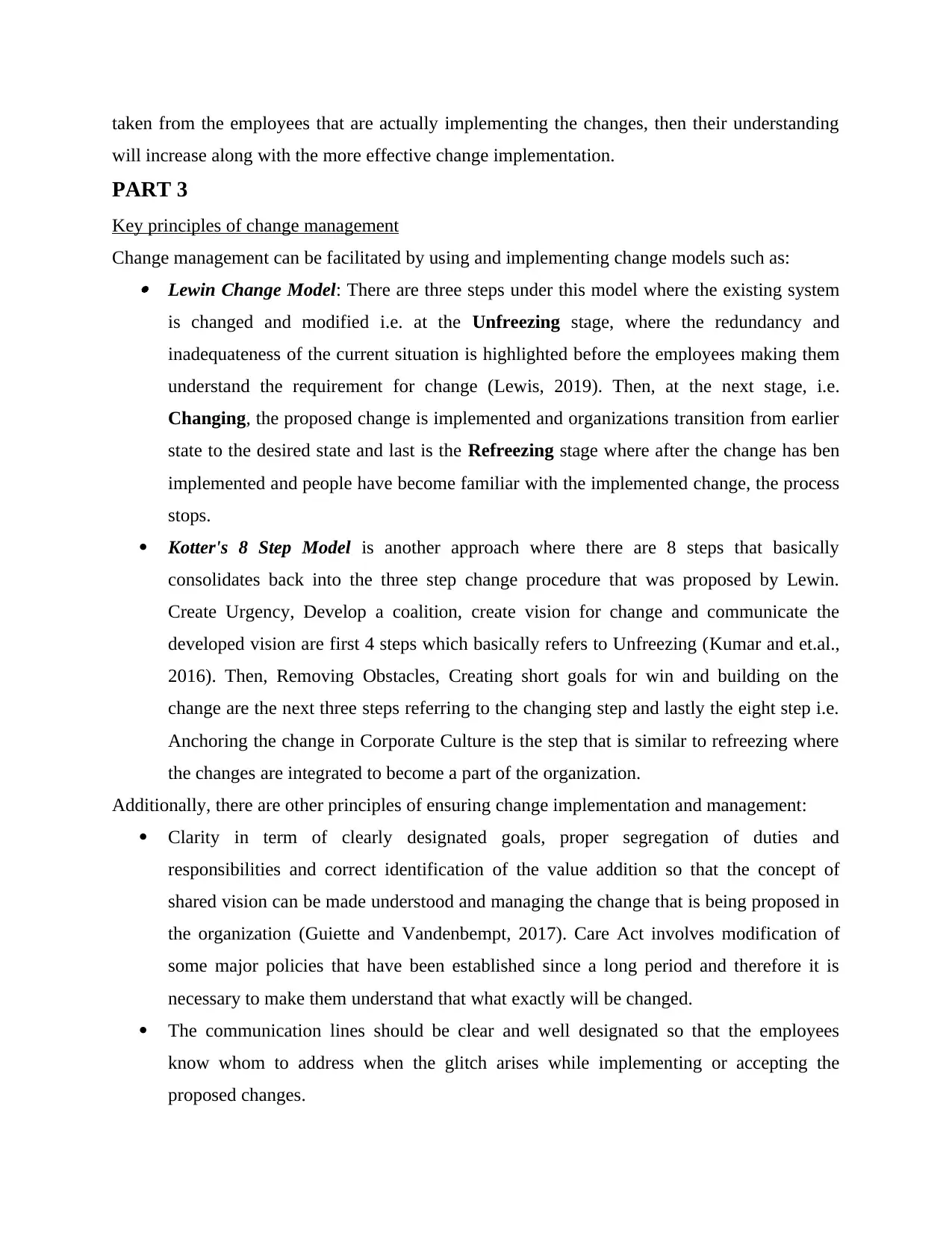
taken from the employees that are actually implementing the changes, then their understanding
will increase along with the more effective change implementation.
PART 3
Key principles of change management
Change management can be facilitated by using and implementing change models such as: Lewin Change Model: There are three steps under this model where the existing system
is changed and modified i.e. at the Unfreezing stage, where the redundancy and
inadequateness of the current situation is highlighted before the employees making them
understand the requirement for change (Lewis, 2019). Then, at the next stage, i.e.
Changing, the proposed change is implemented and organizations transition from earlier
state to the desired state and last is the Refreezing stage where after the change has ben
implemented and people have become familiar with the implemented change, the process
stops.
Kotter's 8 Step Model is another approach where there are 8 steps that basically
consolidates back into the three step change procedure that was proposed by Lewin.
Create Urgency, Develop a coalition, create vision for change and communicate the
developed vision are first 4 steps which basically refers to Unfreezing (Kumar and et.al.,
2016). Then, Removing Obstacles, Creating short goals for win and building on the
change are the next three steps referring to the changing step and lastly the eight step i.e.
Anchoring the change in Corporate Culture is the step that is similar to refreezing where
the changes are integrated to become a part of the organization.
Additionally, there are other principles of ensuring change implementation and management:
Clarity in term of clearly designated goals, proper segregation of duties and
responsibilities and correct identification of the value addition so that the concept of
shared vision can be made understood and managing the change that is being proposed in
the organization (Guiette and Vandenbempt, 2017). Care Act involves modification of
some major policies that have been established since a long period and therefore it is
necessary to make them understand that what exactly will be changed.
The communication lines should be clear and well designated so that the employees
know whom to address when the glitch arises while implementing or accepting the
proposed changes.
will increase along with the more effective change implementation.
PART 3
Key principles of change management
Change management can be facilitated by using and implementing change models such as: Lewin Change Model: There are three steps under this model where the existing system
is changed and modified i.e. at the Unfreezing stage, where the redundancy and
inadequateness of the current situation is highlighted before the employees making them
understand the requirement for change (Lewis, 2019). Then, at the next stage, i.e.
Changing, the proposed change is implemented and organizations transition from earlier
state to the desired state and last is the Refreezing stage where after the change has ben
implemented and people have become familiar with the implemented change, the process
stops.
Kotter's 8 Step Model is another approach where there are 8 steps that basically
consolidates back into the three step change procedure that was proposed by Lewin.
Create Urgency, Develop a coalition, create vision for change and communicate the
developed vision are first 4 steps which basically refers to Unfreezing (Kumar and et.al.,
2016). Then, Removing Obstacles, Creating short goals for win and building on the
change are the next three steps referring to the changing step and lastly the eight step i.e.
Anchoring the change in Corporate Culture is the step that is similar to refreezing where
the changes are integrated to become a part of the organization.
Additionally, there are other principles of ensuring change implementation and management:
Clarity in term of clearly designated goals, proper segregation of duties and
responsibilities and correct identification of the value addition so that the concept of
shared vision can be made understood and managing the change that is being proposed in
the organization (Guiette and Vandenbempt, 2017). Care Act involves modification of
some major policies that have been established since a long period and therefore it is
necessary to make them understand that what exactly will be changed.
The communication lines should be clear and well designated so that the employees
know whom to address when the glitch arises while implementing or accepting the
proposed changes.
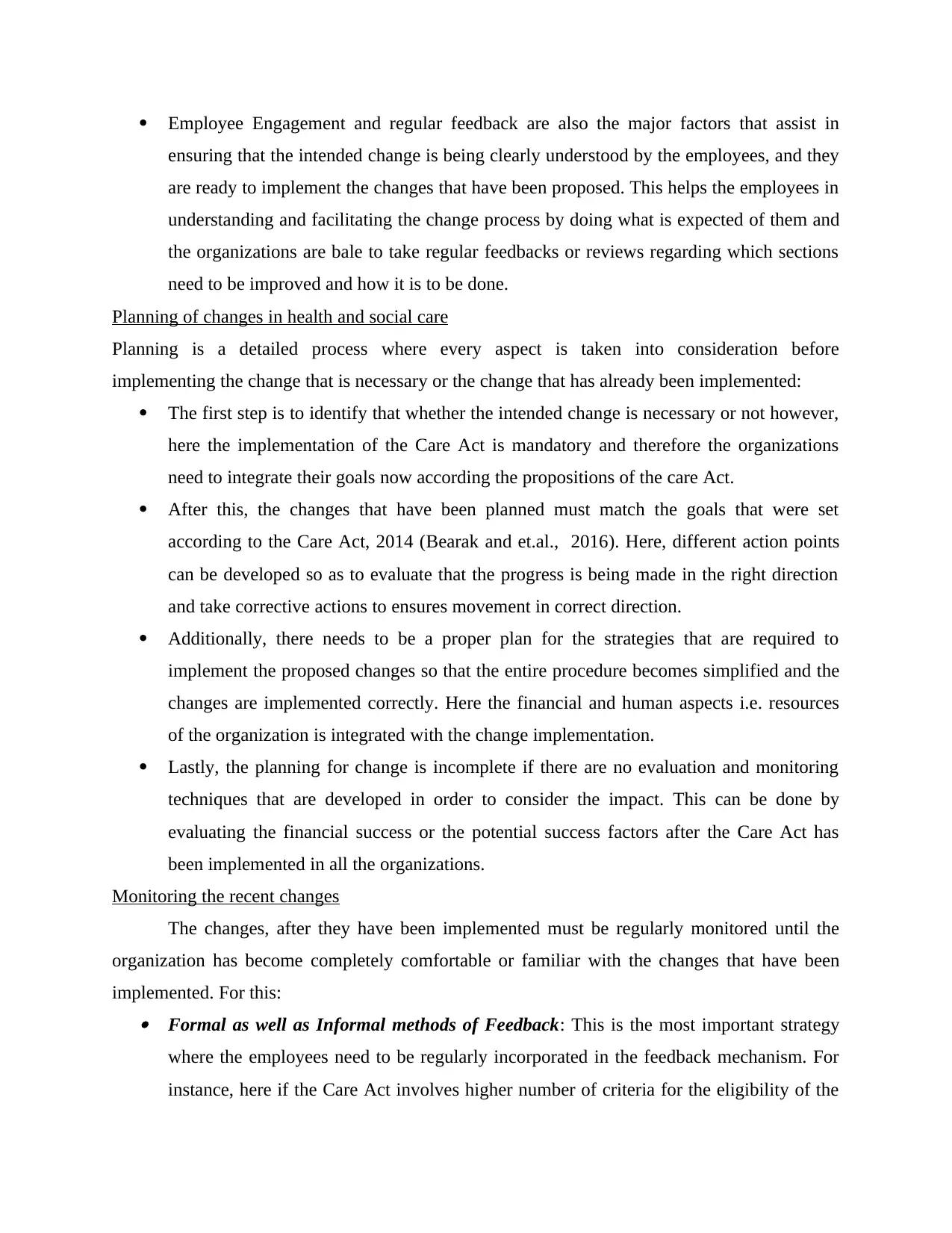
Employee Engagement and regular feedback are also the major factors that assist in
ensuring that the intended change is being clearly understood by the employees, and they
are ready to implement the changes that have been proposed. This helps the employees in
understanding and facilitating the change process by doing what is expected of them and
the organizations are bale to take regular feedbacks or reviews regarding which sections
need to be improved and how it is to be done.
Planning of changes in health and social care
Planning is a detailed process where every aspect is taken into consideration before
implementing the change that is necessary or the change that has already been implemented:
The first step is to identify that whether the intended change is necessary or not however,
here the implementation of the Care Act is mandatory and therefore the organizations
need to integrate their goals now according the propositions of the care Act.
After this, the changes that have been planned must match the goals that were set
according to the Care Act, 2014 (Bearak and et.al., 2016). Here, different action points
can be developed so as to evaluate that the progress is being made in the right direction
and take corrective actions to ensures movement in correct direction.
Additionally, there needs to be a proper plan for the strategies that are required to
implement the proposed changes so that the entire procedure becomes simplified and the
changes are implemented correctly. Here the financial and human aspects i.e. resources
of the organization is integrated with the change implementation.
Lastly, the planning for change is incomplete if there are no evaluation and monitoring
techniques that are developed in order to consider the impact. This can be done by
evaluating the financial success or the potential success factors after the Care Act has
been implemented in all the organizations.
Monitoring the recent changes
The changes, after they have been implemented must be regularly monitored until the
organization has become completely comfortable or familiar with the changes that have been
implemented. For this: Formal as well as Informal methods of Feedback: This is the most important strategy
where the employees need to be regularly incorporated in the feedback mechanism. For
instance, here if the Care Act involves higher number of criteria for the eligibility of the
ensuring that the intended change is being clearly understood by the employees, and they
are ready to implement the changes that have been proposed. This helps the employees in
understanding and facilitating the change process by doing what is expected of them and
the organizations are bale to take regular feedbacks or reviews regarding which sections
need to be improved and how it is to be done.
Planning of changes in health and social care
Planning is a detailed process where every aspect is taken into consideration before
implementing the change that is necessary or the change that has already been implemented:
The first step is to identify that whether the intended change is necessary or not however,
here the implementation of the Care Act is mandatory and therefore the organizations
need to integrate their goals now according the propositions of the care Act.
After this, the changes that have been planned must match the goals that were set
according to the Care Act, 2014 (Bearak and et.al., 2016). Here, different action points
can be developed so as to evaluate that the progress is being made in the right direction
and take corrective actions to ensures movement in correct direction.
Additionally, there needs to be a proper plan for the strategies that are required to
implement the proposed changes so that the entire procedure becomes simplified and the
changes are implemented correctly. Here the financial and human aspects i.e. resources
of the organization is integrated with the change implementation.
Lastly, the planning for change is incomplete if there are no evaluation and monitoring
techniques that are developed in order to consider the impact. This can be done by
evaluating the financial success or the potential success factors after the Care Act has
been implemented in all the organizations.
Monitoring the recent changes
The changes, after they have been implemented must be regularly monitored until the
organization has become completely comfortable or familiar with the changes that have been
implemented. For this: Formal as well as Informal methods of Feedback: This is the most important strategy
where the employees need to be regularly incorporated in the feedback mechanism. For
instance, here if the Care Act involves higher number of criteria for the eligibility of the
⊘ This is a preview!⊘
Do you want full access?
Subscribe today to unlock all pages.

Trusted by 1+ million students worldwide
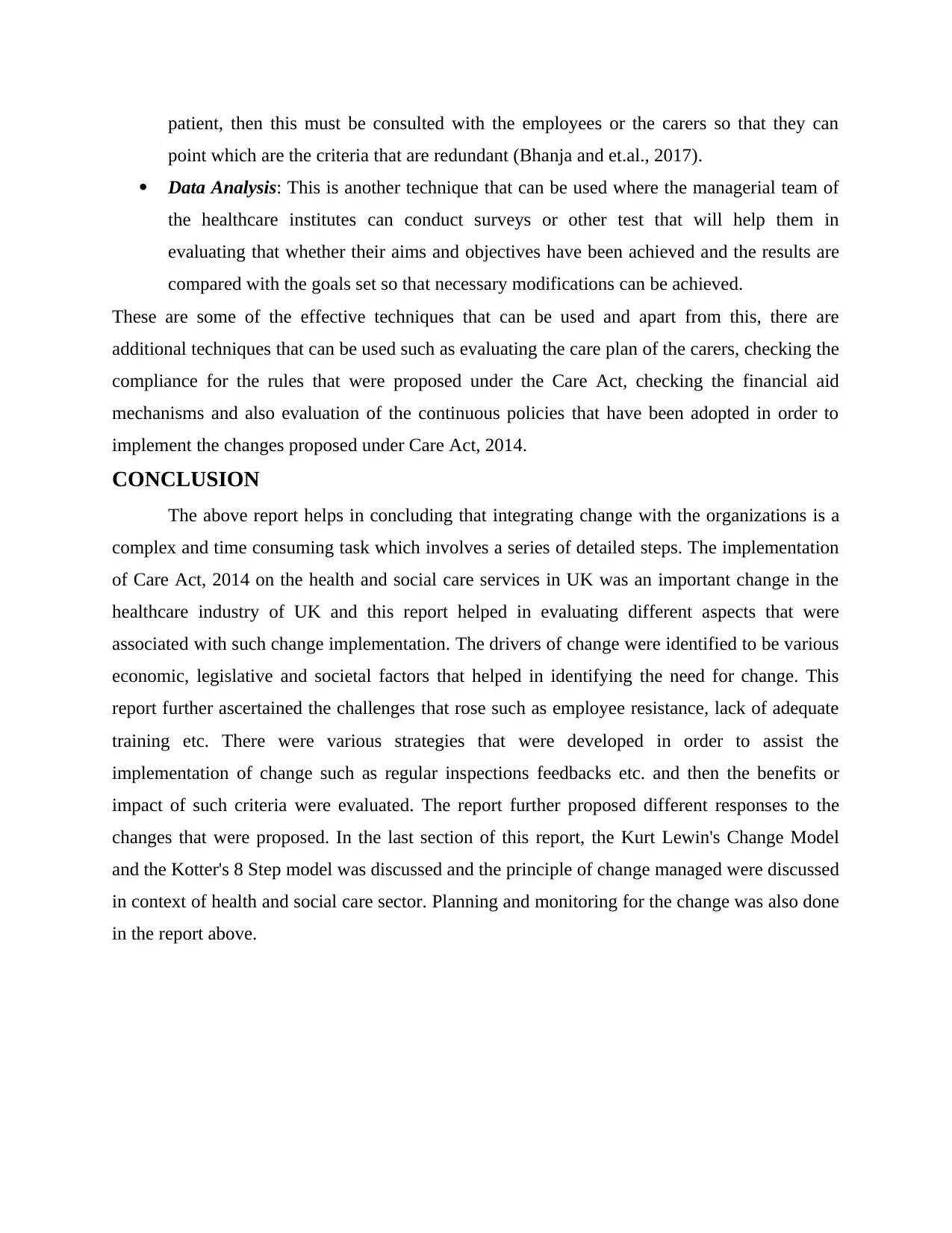
patient, then this must be consulted with the employees or the carers so that they can
point which are the criteria that are redundant (Bhanja and et.al., 2017).
Data Analysis: This is another technique that can be used where the managerial team of
the healthcare institutes can conduct surveys or other test that will help them in
evaluating that whether their aims and objectives have been achieved and the results are
compared with the goals set so that necessary modifications can be achieved.
These are some of the effective techniques that can be used and apart from this, there are
additional techniques that can be used such as evaluating the care plan of the carers, checking the
compliance for the rules that were proposed under the Care Act, checking the financial aid
mechanisms and also evaluation of the continuous policies that have been adopted in order to
implement the changes proposed under Care Act, 2014.
CONCLUSION
The above report helps in concluding that integrating change with the organizations is a
complex and time consuming task which involves a series of detailed steps. The implementation
of Care Act, 2014 on the health and social care services in UK was an important change in the
healthcare industry of UK and this report helped in evaluating different aspects that were
associated with such change implementation. The drivers of change were identified to be various
economic, legislative and societal factors that helped in identifying the need for change. This
report further ascertained the challenges that rose such as employee resistance, lack of adequate
training etc. There were various strategies that were developed in order to assist the
implementation of change such as regular inspections feedbacks etc. and then the benefits or
impact of such criteria were evaluated. The report further proposed different responses to the
changes that were proposed. In the last section of this report, the Kurt Lewin's Change Model
and the Kotter's 8 Step model was discussed and the principle of change managed were discussed
in context of health and social care sector. Planning and monitoring for the change was also done
in the report above.
point which are the criteria that are redundant (Bhanja and et.al., 2017).
Data Analysis: This is another technique that can be used where the managerial team of
the healthcare institutes can conduct surveys or other test that will help them in
evaluating that whether their aims and objectives have been achieved and the results are
compared with the goals set so that necessary modifications can be achieved.
These are some of the effective techniques that can be used and apart from this, there are
additional techniques that can be used such as evaluating the care plan of the carers, checking the
compliance for the rules that were proposed under the Care Act, checking the financial aid
mechanisms and also evaluation of the continuous policies that have been adopted in order to
implement the changes proposed under Care Act, 2014.
CONCLUSION
The above report helps in concluding that integrating change with the organizations is a
complex and time consuming task which involves a series of detailed steps. The implementation
of Care Act, 2014 on the health and social care services in UK was an important change in the
healthcare industry of UK and this report helped in evaluating different aspects that were
associated with such change implementation. The drivers of change were identified to be various
economic, legislative and societal factors that helped in identifying the need for change. This
report further ascertained the challenges that rose such as employee resistance, lack of adequate
training etc. There were various strategies that were developed in order to assist the
implementation of change such as regular inspections feedbacks etc. and then the benefits or
impact of such criteria were evaluated. The report further proposed different responses to the
changes that were proposed. In the last section of this report, the Kurt Lewin's Change Model
and the Kotter's 8 Step model was discussed and the principle of change managed were discussed
in context of health and social care sector. Planning and monitoring for the change was also done
in the report above.
Paraphrase This Document
Need a fresh take? Get an instant paraphrase of this document with our AI Paraphraser
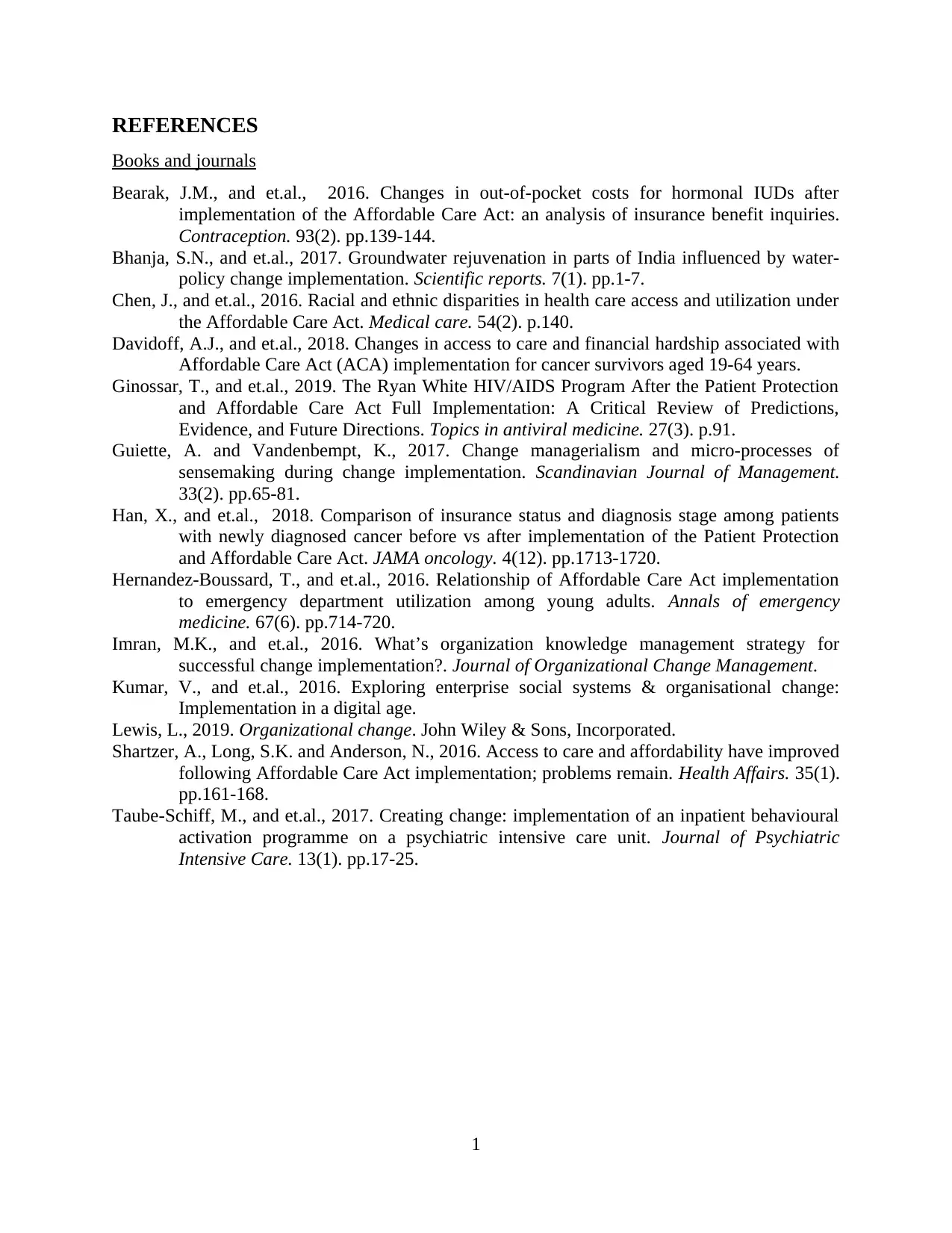
REFERENCES
Books and journals
Bearak, J.M., and et.al., 2016. Changes in out-of-pocket costs for hormonal IUDs after
implementation of the Affordable Care Act: an analysis of insurance benefit inquiries.
Contraception. 93(2). pp.139-144.
Bhanja, S.N., and et.al., 2017. Groundwater rejuvenation in parts of India influenced by water-
policy change implementation. Scientific reports. 7(1). pp.1-7.
Chen, J., and et.al., 2016. Racial and ethnic disparities in health care access and utilization under
the Affordable Care Act. Medical care. 54(2). p.140.
Davidoff, A.J., and et.al., 2018. Changes in access to care and financial hardship associated with
Affordable Care Act (ACA) implementation for cancer survivors aged 19-64 years.
Ginossar, T., and et.al., 2019. The Ryan White HIV/AIDS Program After the Patient Protection
and Affordable Care Act Full Implementation: A Critical Review of Predictions,
Evidence, and Future Directions. Topics in antiviral medicine. 27(3). p.91.
Guiette, A. and Vandenbempt, K., 2017. Change managerialism and micro-processes of
sensemaking during change implementation. Scandinavian Journal of Management.
33(2). pp.65-81.
Han, X., and et.al., 2018. Comparison of insurance status and diagnosis stage among patients
with newly diagnosed cancer before vs after implementation of the Patient Protection
and Affordable Care Act. JAMA oncology. 4(12). pp.1713-1720.
Hernandez-Boussard, T., and et.al., 2016. Relationship of Affordable Care Act implementation
to emergency department utilization among young adults. Annals of emergency
medicine. 67(6). pp.714-720.
Imran, M.K., and et.al., 2016. What’s organization knowledge management strategy for
successful change implementation?. Journal of Organizational Change Management.
Kumar, V., and et.al., 2016. Exploring enterprise social systems & organisational change:
Implementation in a digital age.
Lewis, L., 2019. Organizational change. John Wiley & Sons, Incorporated.
Shartzer, A., Long, S.K. and Anderson, N., 2016. Access to care and affordability have improved
following Affordable Care Act implementation; problems remain. Health Affairs. 35(1).
pp.161-168.
Taube-Schiff, M., and et.al., 2017. Creating change: implementation of an inpatient behavioural
activation programme on a psychiatric intensive care unit. Journal of Psychiatric
Intensive Care. 13(1). pp.17-25.
1
Books and journals
Bearak, J.M., and et.al., 2016. Changes in out-of-pocket costs for hormonal IUDs after
implementation of the Affordable Care Act: an analysis of insurance benefit inquiries.
Contraception. 93(2). pp.139-144.
Bhanja, S.N., and et.al., 2017. Groundwater rejuvenation in parts of India influenced by water-
policy change implementation. Scientific reports. 7(1). pp.1-7.
Chen, J., and et.al., 2016. Racial and ethnic disparities in health care access and utilization under
the Affordable Care Act. Medical care. 54(2). p.140.
Davidoff, A.J., and et.al., 2018. Changes in access to care and financial hardship associated with
Affordable Care Act (ACA) implementation for cancer survivors aged 19-64 years.
Ginossar, T., and et.al., 2019. The Ryan White HIV/AIDS Program After the Patient Protection
and Affordable Care Act Full Implementation: A Critical Review of Predictions,
Evidence, and Future Directions. Topics in antiviral medicine. 27(3). p.91.
Guiette, A. and Vandenbempt, K., 2017. Change managerialism and micro-processes of
sensemaking during change implementation. Scandinavian Journal of Management.
33(2). pp.65-81.
Han, X., and et.al., 2018. Comparison of insurance status and diagnosis stage among patients
with newly diagnosed cancer before vs after implementation of the Patient Protection
and Affordable Care Act. JAMA oncology. 4(12). pp.1713-1720.
Hernandez-Boussard, T., and et.al., 2016. Relationship of Affordable Care Act implementation
to emergency department utilization among young adults. Annals of emergency
medicine. 67(6). pp.714-720.
Imran, M.K., and et.al., 2016. What’s organization knowledge management strategy for
successful change implementation?. Journal of Organizational Change Management.
Kumar, V., and et.al., 2016. Exploring enterprise social systems & organisational change:
Implementation in a digital age.
Lewis, L., 2019. Organizational change. John Wiley & Sons, Incorporated.
Shartzer, A., Long, S.K. and Anderson, N., 2016. Access to care and affordability have improved
following Affordable Care Act implementation; problems remain. Health Affairs. 35(1).
pp.161-168.
Taube-Schiff, M., and et.al., 2017. Creating change: implementation of an inpatient behavioural
activation programme on a psychiatric intensive care unit. Journal of Psychiatric
Intensive Care. 13(1). pp.17-25.
1

2
⊘ This is a preview!⊘
Do you want full access?
Subscribe today to unlock all pages.

Trusted by 1+ million students worldwide
1 out of 12
Related Documents
Your All-in-One AI-Powered Toolkit for Academic Success.
+13062052269
info@desklib.com
Available 24*7 on WhatsApp / Email
![[object Object]](/_next/static/media/star-bottom.7253800d.svg)
Unlock your academic potential
Copyright © 2020–2025 A2Z Services. All Rights Reserved. Developed and managed by ZUCOL.




